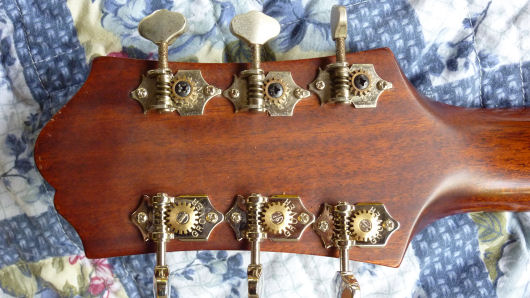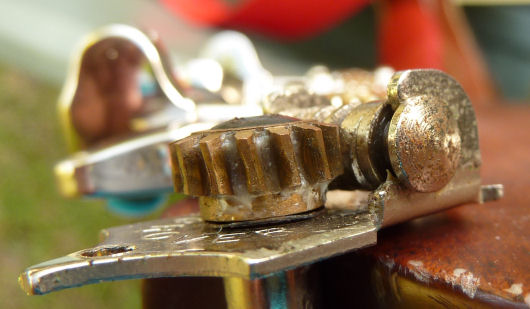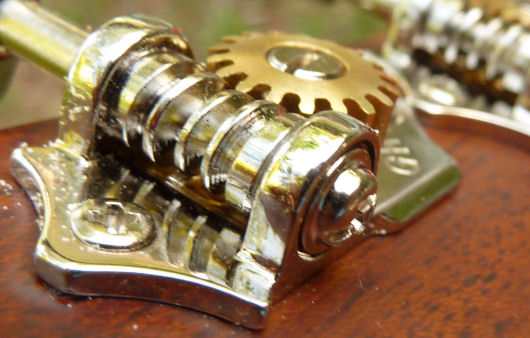New Tuning Pegs for that Masterbilt EF-500M
I’m enjoying some time in Hawai`i and part of the fun is getting back together with my Epiphone Masterbilt EF-500M. This is the first Epi EF-500 I bought, it’s a “second” that I bought used (second squared, I guess). For that last few years I’ve left this guitar in Hawai`i so I don’t have to carry an instrument on the plane.
I’ve tweaked and fiddled with this guitar for a while, especially since I brought it to O`ahu. The humidity is pretty tough on instruments. The tuning machines have always been stiff and they’ve gotten worse lately, so I decided to swap them out for the new Grover Vintage Sta-Tite 18:1 machines. I’ve heard great things about these machines on various guitar forums, and the measurements looked right to be a drop-in replacement for the stock tuning machines. I ordered up a set of #4592 Grover 18:1 Sta-Tites from Stewart-McDonald.
Well, for once luck was with me, and in fact they work and look like they were made for this guitar. Screw holed lined up, the shaft diameters are different but the bushings that came with the new Sta-Tites fit right into the old holes. Here’s a pic of the back of the peghead with half the machines replaced:

Epi Peghead with old and new tuners
These new machines are basically totally different from the originals. The base plate is thicker, the gears are obviously different to provide the higher gear ratio, and the attachment of the gears is totally different as well.
Here’s the original tuning machine:

Original Epi Grover Tuning Machine
Part of the difficulty in turning it is due to the warped base, the rest because the curved arm that holds the shaft has bent, releasing the mesh of the right angle gears.
Here’s the new one:

New Grover Sta-Tite 18:1
Notice how solid and thick the base plate is, and more importantly notice that the shaft is held in a cast mount, a much more solid bit of engineering.
These tuning machines have another fine virtue, they’re not terribly expensive. I bought this set from Stewart-McDonald for $37.37 – I’ve already gotten my money’s worth the first time I changed strings.
This entry was posted on Sunday, September 13th, 2009 at 7:37 pm and is filed under Guitar. You can follow any responses to this entry through the RSS 2.0 feed. You can leave a response, or trackback from your own site.
Walt said in post # 1,
on March 28th, 2010 at 10:47 am
I put the 18:1 Govers on everything. Martins, Nationals, anything of value.
I would put them on my car if I could find a place to stick them.
Christina Iller said in post # 2,
on December 24th, 2010 at 6:16 am
You talked about many engaging things in this posting. I came across this by searching Msn and I must admit that I am now subscribed to your blog, it is extremely fine 🙂
Nigel Lightowler said in post # 3,
on January 27th, 2011 at 6:36 am
Great help,thanks. Looks like I’ll be buying these for my lap steel.